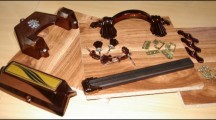Abstract
A 2-year field study has been conducted in an urban environment to provide annual release rates of copper and zinc from brass (20 wt% Zn) and copper and tin from bronze (6 wt% Sn) compared to sheets of their pure alloy constituents, copper and zinc. Despite relatively low nominal bulk alloy content, substantially more zinc was released from brass compared to copper. Both metals were released at a significantly slower rate from the brass alloy, compared to the pure metals. The proportion of release rates of copper and zinc from the alloy differed significantly from their proportions in the bulk alloy. Bronze showed relatively constant release rates of copper, being similar to that of pure copper sheet. The release of tin from bronze was negligible. The results clearly show that alloys and the pure metals behave very differently when exposed to rainwater. Accordingly, release rates from pure metals cannot be used to predict release rates of individual constituents from their alloys. Generated data are of importance within REACH, the new chemical policy of the European commission, where metal alloys erroneously are being treated as mixtures of chemical substances.
Similar content being viewed by others
References
Ateya, B. G., & Pickering, H. W. (1996). The effects of potential and kinetic parameters on the formation of passivating noble metal rich surface layers during the selective dissolution of binary alloys. Corrosion Science, 38(8), 1245–1267.
Bertling, S., Odnevall Wallinder, I., Berggren, D., & Leygraf, C. (2006a). Long term corrosion-induced copper runoff from natural and artificial patina and its environmental fate. Environmental Toxicology and Chemistry, 25(3), 891–898.
Bertling, S., Odnevall Wallinder, I., Leygraf, C., & Berggren, K. D. (2006b). Occurrence and fate of corrosion-induced zinc in runoff water from external structures. The Science of the Total Environment, 367(2–3), 908–923.
Dinnappa, R. K., & Mayanna, S. M. (1987). The dezincification of brass and its inhibition in acidic chloride and sulphate solutions. Corrosion Science, 27(4), 349–361.
El-Sherif, R. M., Ismail, K. M., & Badawy, W. A. (2004). Effect of Zn and Pb as alloying elements on the electrochemical behavior of brass in NaCl solutions. Electrochimica Acta, 49, 5139–5150.
Erlebacher, J., Aziz, M. J., Karma, A., Dimitrov, N., & Sieradzki, K. (2001). Evolution of Nanoporosity in Dealloying. Nature, 410, 450–453.
Faller, M., & Reiss, D. (2005). Runoff behaviour of metallic materials used for roofs and facades – a 5-year field exposure study in Switzerland. Materials and Corrosion, 56(4), 244–249.
He, W., Odnevall Wallinder, I., & Leygraf, C. (2000). A laboratory study of copper and zinc runoff during first flush and steady state conditions. Corrosion Science, 43(1), 127–146.
Herting, G., Odnevall Wallinder, I., & Leygraf, C. (2005). A comparison of release rates of Cr, Ni and Fe from stainless steel alloys and the pure metals exposed to simulated rain events. Journal of Electrochemical Society, 152(1), B23–B29.
Holm, R., & Mattsson, E. (1982). Atmospheric corrosion tests of copper and copper alloys in Sweden – 16-year results. In S. W. Dean & E. C. Rhea (Eds.), Atmospheric corrosion of metals, AST STP 767 (pp. 85–105). American Society for Testing and Materials.
Jouen, S., Hannoyer, B., Barbier, A., Kasperek, J., & Jean, M. (2004). A comparison of runoff rates between Cu, Ni, Sn and Zn in the first steps of exposition in a French industrial atmosphere. Materials Chemistry and Physics, 85, 73–80.
Marshakov, I. K. (2002). Anodic dissolution and selective corrosion of alloys. Protection of Metals, 38(2), 118–123.
Mazza, F., & Torchio, S. (1983). Factors influencing the susceptibility to intergranular attack, stress corrosion cracking and de-alloying attack of aluminium brass. Corrosion Science, 23, 1053–1071.
Rehan, H. H., Al-Moubarak, N. A., & Al-Rafai, H. A. (2001). A model for prolonged dezincification of α-brasses in 3% sodium chloride buffer solutions at different pH values. Materials and Corrosion, 52, 677–684.
Sastri, V. S. (2005). Dezincification studies of some copper based alloys. Corrosion Engineering Science and Technology, 40(2), 171–176.
Selvaraj, S., Ponmariappan, S., Natesan, M., & Palaniswamy, N. (2003). Dezincification of brass and its control – an overview. Corrosion Reviews, 21(1), 41–74.
Shreir, L. L, Jarman, R. A., & Burstein, G. T. (2000). In corrosion, vol. I, Third Edn. Butterworth Heinemann.
Sougrati, M. T., Jouen, S., Hannoyer, B., Barbier, A. (2006). A study of Copper and Copper alloys runoff in urban atmosphere, proceedings copper 2006: better properties for innovative products. Compiègne, France, Sept 12–15.
Sundberg, R., Holm, R., Hertzman, S., Hutchinson, B., & Lindh-Ulmgren, E. (2003). Dezincification (DA) and intergranular corrosion (IGA) of brass – Influence of composition and heat treatment. Metall, 57(11), 721–731.
Tidblad, J., Leygraf, C., & Kucera, V. (1994). Acid deposition effects on materials: evaluation of electric contact materials after 4 years of exposure, ASTM STP 1239. In W. W. Kirk & Herbert H. Lawson (Eds.). American Society for Testing and Materials, Philadelphia.
Wagner, C. (1956). Oxidation of alloys involving noble metals. Journal of Electrochemical Society, 571–580.
Author information
Authors and Affiliations
Corresponding author
Rights and permissions
About this article
Cite this article
Herting, G., Goidanich, S., Odnevall Wallinder, I. et al. Corrosion-induced release of Cu and Zn into rainwater from brass, bronze and their pure metals. A 2-year field study. Environ Monit Assess 144, 455–461 (2008). https://doi.org/10.1007/s10661-007-0008-5
Received:
Accepted:
Published:
Issue Date:
DOI: https://doi.org/10.1007/s10661-007-0008-5




